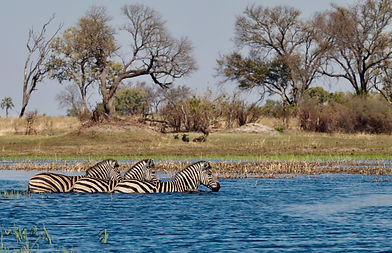WILDLIFE
Thanks to the different landscapes in the country, Botswana offers a great and unique biodiversity. The combination of dry areas and wet delta offers an ideal habitat for wild animals.
Botswana is home to over 160 species of mammals, including herbivores, carnivores and primates, approximately 550 species of birds and over 150 species of reptiles
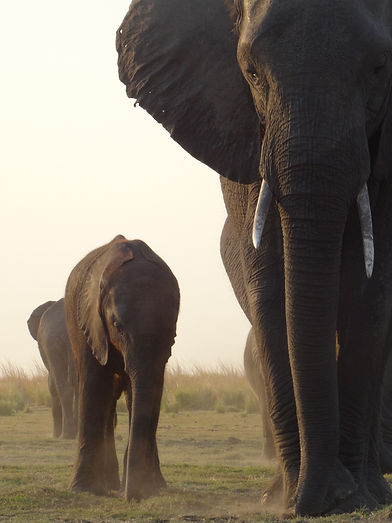
African Elephant
Tlou (tsn)
Loxodonto africana (lat)
Botswana is home to the world’s largest population of approximately 130 000 elephants.
The highest concentration of those gentle giants can be found in the Chobe National Park. It is not uncommon during the dry winter months to see the floodplains of the Chobe River literally covered with Elephants.
The African elephant is a so called "keystone species", meaning they play an important role in their ecosystem. Also known as “ecosystem engineers,” elephants affect their habitat in many ways. As they spend most of the time eating, their feasting on trees and shrubs creates pathways for smaller animals to move through. They also help keeping the landscape open for zebras and other plains animals to thrive.
As elephants only digest less than 50 % of their food, their dung is full of seeds, helping plants to spread and it makes pretty good habitat for dung beetles too. During the dry season, they use their tusks to dig up dry riverbeds and provide access to water for many other species.
Did you know?
-
There are close to 40,000 muscles in an elephant trunk.
Hippopotamus
Kubu (tsn)
Hippopotamus amphibius (lat)
Hippos play an important part in maintaining and conserving the Okavango Delta. As they push through the reeds and sedges, they keep the channels of the Delta open. Elsewise the vegetation would choke the waterways and the waters would re-route and flow elsewhere. That's why one of the most common noises while you enjoy a sundowner in the Delta is the "laughing" of a hippo.
Hippos mostly stay in water during the day and leave the water during the night to graze. Considering their enormous size, a hippo’s food intake is relatively low.
Hipps cannot breathe under water but an adult can stay submerged for about 5 minutes.The process of surfacing and breathing is automatic, and even a hippo sleeping underwater will rise and breathe without waking.
Did you know?
-
Hippos are not able to swim in the true sense. They literally walk under water and bound and bounce along the bottom and use their tail as a rudder.
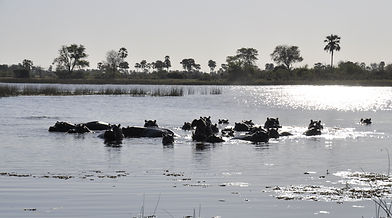
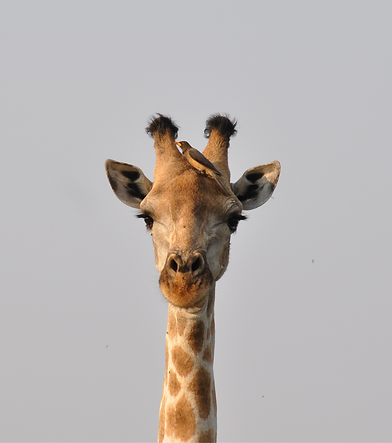
Giraffe
Thutlwa (tsn)
Giraffa camelopardalis (lat)
Giraffes always have had a special presence in the human culture, always represented as a kind, beautiful, elegant and peaceful animal, but at the same time powerful and able to defend itself when necessary.
Giraffes are unique in many ways, they look tall and lanky and walk differently, but there is more to them just what meets the eye. Giraffes do not have front teeth in their top jaw, this helps them cram more buds and leaves into their mouth. Their tongue is prehensile which allows them to grip the leaves and pull, much like how we use our hand. They have a good colour vision, very good sense of smell and a very good hearing. Unlike popular belief, giraffes do have vocal chords and they do emit sound when needed, both to communicate among their own and to keep predators away.
Did you know?
-
Despite its huge length, a giraffe has the same number of vertebrae in its neck as a human - just seven bones.
Lion
Tau (tsn)
Panthera leo (lat)
Lions are second only in size to tigers among the big cats. They are powerful enough to kill large, dangerous prey such as zebras and buffalo. Unusually for cats, lions live in groups and often hunt cooperatively. Thee behaviorsmay be linked to their open savanna habitat. Male lions look quite unlike females. Such sexual dimorphism is also unique among the cats.
A mature male typically weighs up to 530 pounds (240 kg), and the heaviest ever recorded weighed a colossal 690 pounds (312 kg). A male lion looks even bigger than it really is, thanks to the luxuriant mane that covers its head and shoulders. The magnificent mane of a mature male lion can vary from a light, tawny yellow to dark brown or even black. It takes five to seven years to achieve its full length, and tends to get darker each year. Female lions may prefer males with a dark mane, but males use their mane primarily to impress rival males. The mane also helps protect the neck, which is an obvious target during fights.
Did you know?
-
A lion's roar can reach 114 decibels and can be heard from about 8km away.

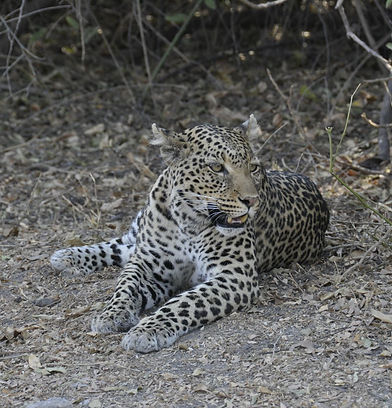
Leopard
Nkwe (tsn)
Panthera pardus (lat)
Leopards have the widest geographic distribution. This is due to their flexibility in habitat and having a varied diet. Leopard cubs are born completely blind and are incredibly vulnerable. They rely entirely on their mother to survive. When they are about 10 days old their eyes begin to open and are bright blue during their first few months of life. Leopards do not have a season to breed and, meaning they can breed the whole year around if factors like prey and habitats are favourable.
Leopards are solitary animals. They each have their own territory, and leave scratches on trees, urine scent marks and poop to warn other leopards to stay away! Males and females will cross territories, but only to mate. They love to hunt under the cover of darkness as it also provides them the advantage of better sight and camouflage and thus increase their success of hunting.
Leopards are skilled climbers, and like to rest in the branches of trees during the day. They are strong beasts, too, and can carry their heavy prey up into the trees so that pesky scavengers, such as hyenas, don’t steal their meal!
Did you know?
-
Leopards can run at up to 60km/h and can leap 6m forward through the air – that’s the length of three adults lying head to toe
Plains Zebra
Pitse Ya Naga (tsn)
Equus quagga (lat)
In Botswana there is only one type of Zebra that occurs: the plains or burchell's Zebra. It is the national animal of Botswana and is well-known for its distinctive stripes.
They live in small family groups, called harem, consisting of a male (stallion), several females, and their young. Amongst the mares there is a strict hierarchy which is linked to age.
Zebras are generally widespread except for the drier central regions of Botswana. Most common sightings are in the Okavango Delta, Chobe National Park and Savute. During the rainy season a huge dazzle of zebra migrate to the Makgadikgadi Pans.
Did you know?
-
Even though zebras are strictly grazers, they've been known to browse occasionally, most probably at the hardest times of the year when there is little else available. They also dig up the rhizomes (underground stems) of grasses that are often more succulent than the above ground parts, particularly in winter.
